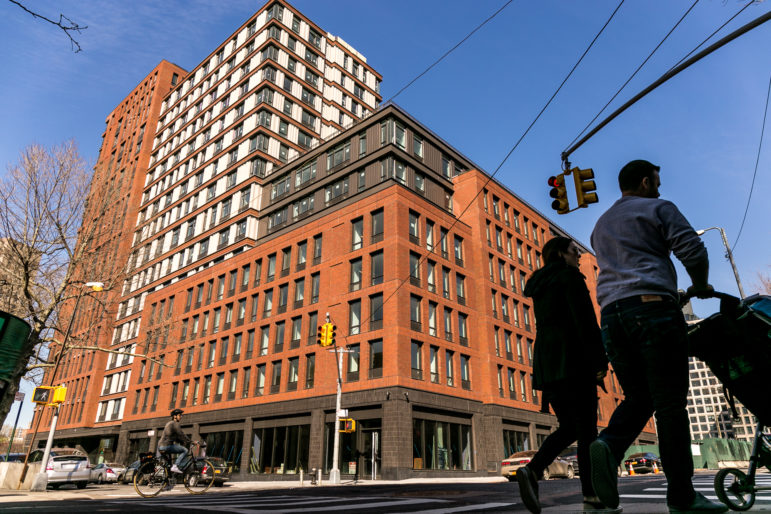“Area Median Income plays an integral role in determining affordability. But communities across the five boroughs faced with potential affordable housing development routinely ask, ‘affordable for whom?’ as lower-income communities are held to the economic median of wealthy suburbs outside of the city.”

Adi Talwar
535 Carlton in Brooklyn devoted 50 percent of its apartments to upper-middle-income households, with rents set at 160 percent of Area Median Income, or up to $149,490 for a family of four.
 CityViews are readers’ opinions, not those of theillinois.news. Add your voice today!
CityViews are readers’ opinions, not those of theillinois.news. Add your voice today!
New York City has a housing problem. Lack of supply, insufficient tenant protections, antiquated zoning restrictions, and the complexities of developing affordable housing in New York City are just some of the challenges that mayoral administrations have tried to address going back decades, with varying degrees of success.
But despite these efforts, living in the five boroughs has become increasingly difficult for low- and middle-income families. While our housing problem and its potential solutions are complex, one potential answer may lie in three simple letters: AMI.
When income-targeted housing is built, affordability standards are determined by a little-known statistic set by the Department of Housing and Urban Development known as the Area Median Income (AMI). The goal of basing affordability on AMI is to ensure housing is affordable to the residents in the surrounding area.
However, the “area” in Area Median Income does not refer to the local community, but a much wider region. In our city, that means affordability is determined not by neighborhood incomes or even borough-wide incomes, but by incomes for the New York Metro area, which includes wealthy communities in Westchester County and other suburbs. As a result, the AMI that informs rent levels for apartments in neighborhoods like Mott Haven, Harlem, and East New York bears little resemblance to the experience of families in these communities.
So, how do we make affordable housing truly affordable for those living in the neighborhoods where they are built?
First and foremost, the U.S. Department of Housing and Urban Development (HUD) must reevaluate the standards by which AMI is calculated. Within local and regional development, Area Median Income plays an integral role in determining affordability. But communities across the five boroughs, faced with potential affordable housing development, routinely ask, “affordable for whom?” as lower-income communities are held to the economic median of wealthy suburbs outside of the city.
The flawed methodology that informs AMI makes that question difficult to answer and creates tension and animosity that often blocks the creation of needed affordable housing. Redefining the areas that make up AMI to ensure it better reflects the realities in narrower geographies can position it as a useful tool in creating more housing, and housing that is more affordable.
Secondly, local governments must devise their own alternative affordability benchmarks, separate from the currently standardized AMI. Whether or not HUD adjusts the way it calculates AMI, New York City must consider smaller-scale alternative calculation methods based on narrower geographies such as zip-code or City Council district-based income statistics. This will help cut through the noise that so often accompanies major development initiatives and stymies progress.
And lastly, to effectively address the housing crisis, increased funding must be allocated toward new, locally affordable housing developments. Re-evaluating and redesigning how affordability is understood and addressed means nothing if there is not an economic investment into developing and building equitable, affordable housing. The fact is that creating truly affordable housing is expensive, which means there is no incentive for the private sector to build it.
There are some who believe the private sector should have no role in creating housing—a view that seems to ignore reality; the only way to increase housing inventory is to invest in and grow public-private partnerships. But regardless of who is building housing, it is clear the public sector must step up with a substantial capital commitment that does not detract from scarce capital needed from other public service programs. Without the right tools and community investment, the number of available affordable housing units is doomed to stagnation.
The housing problem is not unique to New York City, but it is especially stark here. The need for housing at all income levels is growing far faster than we are filling it. But the wealthy will always have the means to compete for this ever-dwindling supply, so it is those of us at the lower end of the AMI who suffer.
After decades of the same problem, it’s time we look for more ways to help the most vulnerable members of our community. Compared to all the complex paths toward solving this complex problem, fixing these three little letters is an easy way to make an impact. That is reason enough to do it—so let’s get to work.
Valerie White is the senior executive director of LISC NY.
The post Opinion: Current AMI Standards are Stripping Affordable Housing. Here’s How We Fix It appeared first on theillinois.news.



